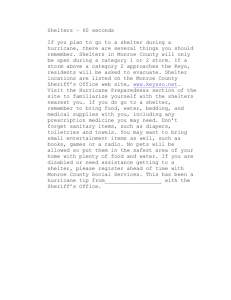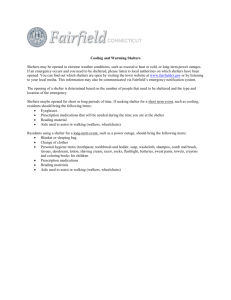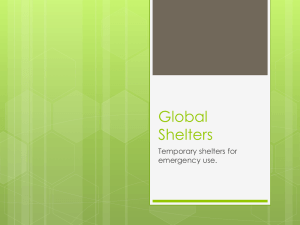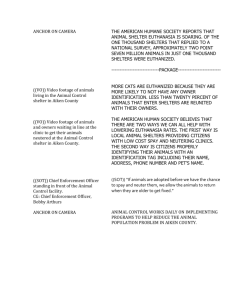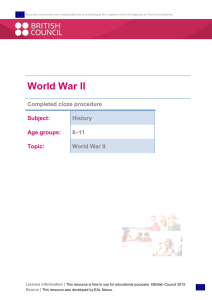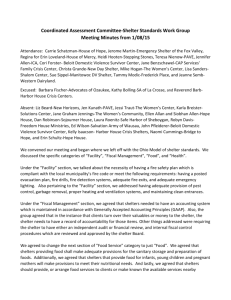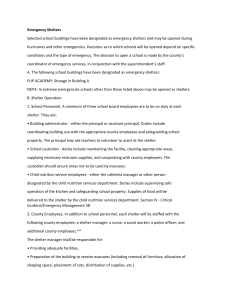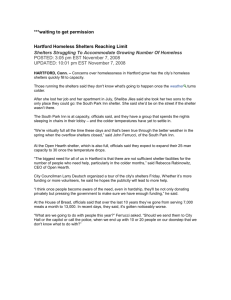General Welfare Committee Staff: Andrea Vazquez, Counsel
advertisement
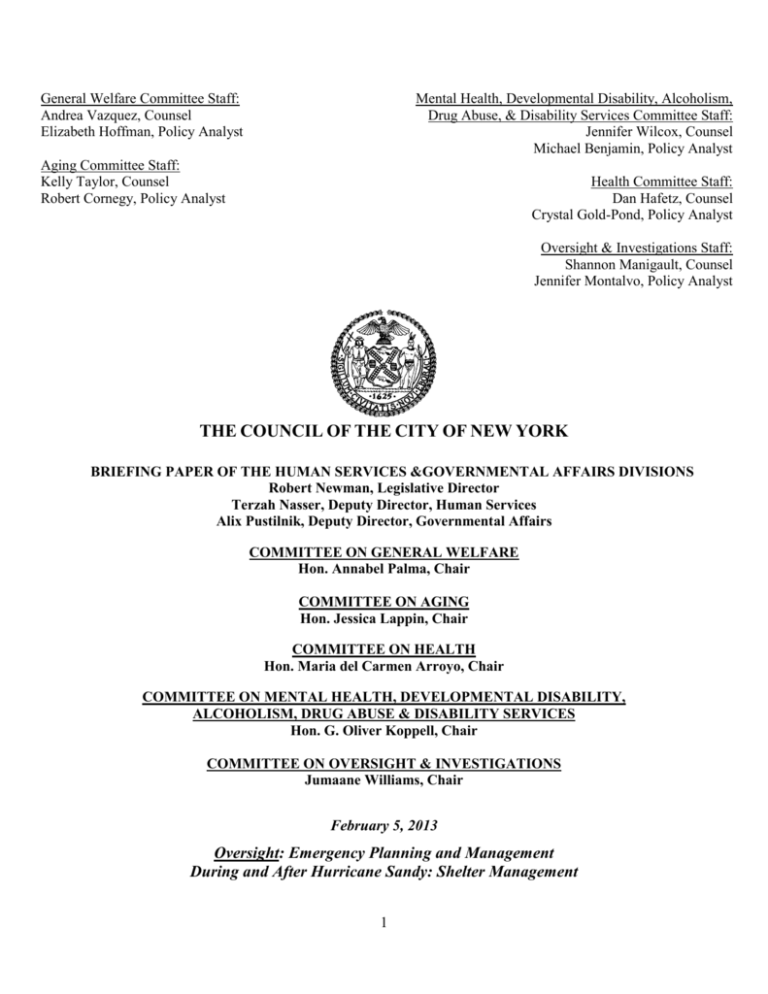
General Welfare Committee Staff: Andrea Vazquez, Counsel Elizabeth Hoffman, Policy Analyst Mental Health, Developmental Disability, Alcoholism, Drug Abuse, & Disability Services Committee Staff: Jennifer Wilcox, Counsel Michael Benjamin, Policy Analyst Aging Committee Staff: Kelly Taylor, Counsel Robert Cornegy, Policy Analyst Health Committee Staff: Dan Hafetz, Counsel Crystal Gold-Pond, Policy Analyst Oversight & Investigations Staff: Shannon Manigault, Counsel Jennifer Montalvo, Policy Analyst THE COUNCIL OF THE CITY OF NEW YORK BRIEFING PAPER OF THE HUMAN SERVICES &GOVERNMENTAL AFFAIRS DIVISIONS Robert Newman, Legislative Director Terzah Nasser, Deputy Director, Human Services Alix Pustilnik, Deputy Director, Governmental Affairs COMMITTEE ON GENERAL WELFARE Hon. Annabel Palma, Chair COMMITTEE ON AGING Hon. Jessica Lappin, Chair COMMITTEE ON HEALTH Hon. Maria del Carmen Arroyo, Chair COMMITTEE ON MENTAL HEALTH, DEVELOPMENTAL DISABILITY, ALCOHOLISM, DRUG ABUSE & DISABILITY SERVICES Hon. G. Oliver Koppell, Chair COMMITTEE ON OVERSIGHT & INVESTIGATIONS Jumaane Williams, Chair February 5, 2013 Oversight: Emergency Planning and Management During and After Hurricane Sandy: Shelter Management 1 I. Introduction On February 5, 2013, the Committee on General Welfare, chaired by Council Member Annabel Palma; the Committee on Aging, chaired by Council Member Jessica Lappin; the Committee on Health, chaired by Council Member Maria del Carmen Arroyo; the Committee on Oversight and Investigations, chaired by Council Member Jumaane Williams, and the Committee on Mental Health, Developmental Disability, Alcoholism, Drug Abuse, and Disability Services, chaired by Council Member G. Oliver Koppell (collectively “the Committees”), will hold an oversight hearing entitled “Emergency Planning and Management During and After the Storm: Shelter Management.” This hearing will explore and review the management and conditions of evacuation shelters and the services provided to evacuees, storm victims’ access to shelters, the treatment of populations with special medical needs in evacuation shelters, and the system of hotels used as transitional shelters. Witnesses invited to testify include representatives of the New York City Department of Homeless Services, the New York City Department for the Aging, the New York City Department of Health and Mental Hygiene, the New York City Health and Hospitals Corporation, advocates and volunteers. This is the fifth in a series of Hurricane Sandy related oversight hearings conducted by the Council. II. Hurricane Sandy and Emergency Sheltering The extreme weather conditions during Hurricane Sandy created an unprecedented need for emergency shelter in New York City. Logistics to relocate and shelter those in need were planned by the Office of Emergency Management (“OEM”) and administered by the Department of Homeless Services (“DHS”) in partnership with several other City agencies. According to OEM Commissioner Bruno’s testimony at a January 16th New York City Council hearing on Emergency Planning and Management During and After Hurricane Sandy: 2 Disaster Management (“the January 16th hearing”), OEM activated the City’s Coastal Storm Plan (“CSP”) and its Flash Flood Emergency Plan on Thursday, October 25th. By activating these plans several City agencies transitioned to emergency operations, which includes increasing staffing plans, notifying City employees who are designated as emergency shelter staff that they could be called on to volunteer, opening evacuation centers and shelters, including Special Medical Needs Shelters, and mobilizing the Emergency Shelter Supply Stockpile.1 By Friday, October 26th OEM activated the Emergency Operations Center, which was the central management center for the City’s response to the storm. Concurrently, the Logistic Center opened where supply requests were sent and the Emergency Shelter Supply Stockpile was deployed to the City’s shelter system. By Friday evening shelter staff were notified they must report for shelter duty at 8:00 am Saturday morning when the Unified Operations Resource Center (“UORC”) was activated, which serves as the shelter management center as identified in the CSP.2 III. Evacuation Shelters Examining how displaced residents were able to access adequate shelters Accessing temporary evacuation centers The City disseminated information concerning temporary evacuation shelters through varied means: in addition to announcing where shelters were located during press conferences and in press releases, details were posted on the OEM website and were available via 311. 3 1 Testimony of OEM Commissioner Joe Bruno before the Committee on Public Safety, the Committee on Fire & Criminal Justice Services, the Committee on Aging, the Committee on General Welfare, the Committee on Health and the Committee on Mental Health, Developmental Disability, Alcoholism, Drug Abuse & Disability Services. January 16, 2013 (on file with Committees). 2 Id. 3 See Press Release, Mayor Bloomberg Issues Order for Mandatory Evacuation of Low-Lying Areas as Hurricane Sandy Approaches (Oct. 28, 2012); Press Release, Statement of Mayor Michael R. Bloomberg On Preparations for Hurricane Sandy (Oct. 29, 2012). 3 Mayor Bloomberg encouraged evacuees to access the shelters via public transportation. 4 He also suggested that evacuees unable to make it to shelters on their own reach out to 311 to arrange transportation.5 For evacuees seeking to drive to shelters, Mayor Bloomberg cautioned that the school buildings being used as shelters might not have available parking. 6 The website of the Mayor's Office for People with Disabilities also provided information about accessible transportation to the shelters.7 Each of the shelters had at least one wheelchair accessible entrance.8 Buses provided by the Department of Education were sent to all of the 26 public housing developments in Zone A to help take the 45,000-plus residents of these developments to dedicated shelters.9 To help relay information regarding the availability of temporary evacuation shelters and the bus transportation to the shelters for public housing residents, the City telephoned residents, knocked on doors, circulated flyers, and used loudspeakers.10 As temperatures dropped, on November 3rd, 2012, the City also offered bus service from the City’s disaster assistance centers to transport individuals from hard-hit areas lacking heat and electricity to temporary evacuation shelters.11 As part of this effort, NYPD officers distributed flyers detailing bus location addresses, hours of operation and issued announcements using patrol 4 Id. Id. 6 See Press Release, Mayor Bloomberg Issues Order for Mandatory Evacuation of Low-Lying Areas as Hurricane Sandy Approaches (Oct. 28, 2012). 7 See Press Release, Mayor Bloomberg Updates New Yorkers on City Preparations for Hurricane Sandy and Steps New Yorkers Should Take to Prepare (Oct. 27, 2012); Press Release, Mayor Bloomberg Issues Order for Mandatory Evacuation of Low-Lying Areas as Hurricane Sandy Approaches (Oct. 28, 2012); Press Release, Statement of Mayor Michael R. Bloomberg On Preparations for Hurricane Sandy (Oct. 29, 2012). 8 See Press Release, Mayor Bloomberg Updates New Yorkers on City Preparations for Hurricane Sandy and Steps New Yorkers Should Take to Prepare (Oct. 27, 2012); Press Release, Mayor Bloomberg Issues Order for Mandatory Evacuation of Low-Lying Areas as Hurricane Sandy Approaches (Oct. 28, 2012); Press Release, Mayor Bloomberg Visits One of City's 76 Evacuation Centers and Urges New Yorkers in Low-Lying Areas to Comply With Mandatory Evacuation Order (Oct. 28, 2012); Press Release, Statement of Mayor Michael R. Bloomberg On Preparations for Hurricane Sandy (Oct. 29, 2012). 9 See Press Release, Mayor Bloomberg Issues Order for Mandatory Evacuation of Low-Lying Areas as Hurricane Sandy Approaches (Oct. 28, 2012). 10 See Press Release, Statement of Mayor Michael R. Bloomberg On Preparations for Hurricane Sandy (Oct. 29, 2012). 11 See Press Release, Mayor Bloomberg Updates New Yorkers on City Response To Hurricane Sandy (Nov. 3, 2012). 5 4 car loudspeakers.12 Information regarding shelter locations, bus shuttle schedules and daytime warming centers was listed on their website at www.nyc.gov.13 Options once temporary evacuation shelters were closed when schools reopened Initially, Hurricane Sandy evacuees sought refuge in City temporary evacuation shelters, all of which were housed in public school buildings.14 As the City consolidated evacuation shelters in the aftermath of the storm, in order to better allocate resources and manage the disparate population of evacuees in shelters and to prepare for the re-opening of City schools after the storm, many evacuees needed to be transferred to other available facilities.15 Some evacuees were assigned to existing homeless shelters or YMCAs throughout the City.16 Other evacuees, approximately 1,000 individuals from temporary evacuation shelters, were assigned to one of 29 hotels located throughout the five boroughs funded by the City, where the Red Cross and City agencies assisted evacuees in obtaining long-term and short-term living assistance from FEMA.17 FEMA provided some evacuees with a $1,000 per month stipend to help pay for temporary housing. 18 To the extent that DHS authorized the transfer of evacuees as it deemed appropriate and/or necessary, today, the Committees hope to learn what criteria, if any, DHS used in determining where to assign evacuees—including determinations of both assignments to shelters 12 Id. See Press Release, Mayor Bloomberg Advises of Cold Weather Precautions as City Provides Buses to Shelters, Opens Warming Centers and Distributes Blankets (Nov. 3, 2012). 14 See Press Release, Mayor Bloomberg Updates New Yorkers on City Preparations for Hurricane Sandy and Steps New Yorkers Should Take to Prepare (Oct. 27, 2012); Press Release, Mayor Bloomberg Issues Order for Mandatory Evacuation of Low-Lying Areas as Hurricane Sandy Approaches (Oct. 28, 2012); Press Release, Statement of Mayor Michael R. Bloomberg On Preparations for Hurricane Sandy (Oct. 29, 2012). 15 See Press Release, Mayor Bloomberg Updates New Yorkers on City Response to Hurricane Sandy (Nov. 1, 2012); Press release, Mayor Bloomberg Updates New Yorkers on City Response to Hurricane Sandy (Nov. 2, 2012). 16 Id. 17 Lisa W. Foderaro, City-Paid Hotel Rooms Are No Panacea for 1,000 New Yorkers Displaced by Storm, NEW YORK TIMES, Nov. 29, 2012, available at , http://www.nytimes.com/2012/11/30/nyregion/1000-nyc-stormevacuees-find-hotels-no-panacea.html?_r=0. (last visited Jan. 29, 2013 18 Id. 13 5 versus hotels and the specific assignments within those categories—and what role, if any, evacuees’ placement requests were taken into account. Tracking residents of temporary evacuation centers The reported number of evacuees staying in 76 temporary evacuation shelters ranged from 3,000 on October 29th, 2012 to 6,800 on November 1st, 2012. 19 However, DHS was unable to maintain a daily count of the number of residents in each shelter on each day of the storm. Today’s hearing will explore the challenges that occurred during and after the storm in terms of tracking evacuees, from initial intake, to shelter-to-shelter transfer, to ultimate withdrawal from the temporary evacuation shelter system. Shelter Conditions and Supplies In total, 76 different evacuation shelter facilities were opened in public schools throughout the five boroughs.20 However, according to advocates and newspaper articles, the City’s plan and preparation for evacuees was inadequate. When discussing the evacuation shelters at the January 16th hearing a representative from the Legal Aid Society testified that, “the City failed to prepare food, medical, and other special needs; failed to avoid the co-location of children, adults, and seniors; and failed to anticipate the plan for long-term displacement.”21 Additionally, it was said that there was confusion about the shelter process, which left evacuees and advocates unsure of who was in charge and where to go to get basic supplies such as food, 19 See Press Release, Statement of Mayor Michael R. Bloomberg On Preparations for Hurricane Sandy (Oct. 29, 2012); Press Release, Mayor Bloomberg Updates New Yorkers on City Response to Hurricane Sandy (Nov. 1, 2012). 20 Danielle Tcholakian, Bloomberg Urges Evacuation to Emergency Shelters Intensifies Homeless Outreach, METRO, October 29, 2012. http://www.metro.us/newyork/local/article/1155221--bloomberg-urges-evacuation-toemergency-shelters-intensifies-homeless-outreach (last visited Dec. 2012). 21 Testimony of The Legal Aid Society before the Committee on Public Safety, the Committee on Fire & Criminal Justice Services, the Committee on Aging, the Committee on General Welfare, the Committee on Health and the Committee on Mental Health, Developmental Disability, Alcoholism, Drug Abuse & Disability Services. January 16, 2013 (on file with Committees). 6 medical and social services.22 In order to grapple with the confusion, some evacuation shelters relied on volunteers from the community to coordinate food, services and medical care for the evacuees. A week after the storm, students had to return to school and evacuees had to be transferred out of the school-based evacuation shelters to additional shelters, including armory open drill floors in existing DHS shelters. It has been reported that conditions at some of the armories were unacceptable. According to an article in the New York Times, there were complaints of, “chaotic, unsanitary conditions,” which led to the removing evacuees from existing DHS shelters to hotel rooms across the city.23 The New York Times described the conditions at the Franklin Avenue Armory in the Bronx by saying: “It’s like you were being processed to go to jail,” Mr. Etienne said, echoing many others who described waiting for hours in the cold to enter a vast sea of cots under constant fluorescent lights, with one shower for everybody and one toilet for men, where guards yelled into two-way radios all night and, Mr. Etienne and a Salvation Army official said, a couple had sex in the open.”24 Supplies were made available to evacuation shelters through a network of City, State, Federal, non-profit and community partners. MENLO, a private vendor contracted by the City, manages the Emergency Shelter Supply Stockpile and was responsible for the delivery of cots, blankets, food, water, medical supplies, baby and pet supplies.25 Two days after the storm hit, the Red Cross “realized that the scope of the disaster would require large-scale assistance from outside the city. But, at that point a host of logistical problems made it difficult to expedite 22 Id. Nina Bernstein, Storm Bared a Lack of Options for the Homeless in New York, THE NEW YORK TIMES, November 20, 2012, available at http://www.nytimes.com/2012/11/21/nyregion/storm-worsens-shortage-of-nyc-housing-forhomeless.html?pagewanted=all&_r=0 (last visited Jan. 28). 24 Id. 25 Testimony of Joseph Bruno, supra note 1. 23 7 deliveries overland.”26 By November 1st, the City and the National Guard set up a food and water distribution site at Floyd Bennett Field in Brooklyn where Meals Ready to Eat (“MREs”) and water were distributed. Beginning November 10th, the City began serving hot meals in partnership with the NYC Food Truck Association.27 In many cases non-profit organizations and volunteers in the community rallied to distribute needed supplies to evacuation shelters. However, according to some of the non-profit organizations called upon to help distribute food, a more coordinated approach was needed to adequately service shelters, as well as impacted neighborhoods. According to testimony at the January 16th hearing, the Food Bank and other emergency food providers received phone calls from government and community leaders to report local food needs and to ask for assistance,28 but “it quickly became clear that without a central clearinghouse for these requests, it was impossible to insure against duplication of efforts and limited resources.” 29 According to the Salvation Army, the organization was notified “at a moment’s notice” that evacuees were going to be moved into their existing shelter.30 Due to the rapid pace of relocating evacuees, it has been reported that some armories did not have the supplies needed to house families. For example, according to the New York Times, the Franklin Avenue Armory did not have cribs for babies the first night it was open and some babies fell out of cots onto the floor. 31 Staffing David Carry, American Red Cross Carries on with Hurricane Sandy Recovery After Being Branded a ‘Disgrace’, THE HUFFINGTON POST, November 4, 2012. http://www.huffingtonpost.com/2012/11/04/red-cross-carries-ondesp_0_n_2073855.html (last visited Jan. 29, 2013). 27 Testimony of Joseph Bruno, supra note 1. 28 Testimony of the Food Bank for New York before the Committee on Public Safety, the Committee on Fire & Criminal Justice Services, the Committee on Aging, the Committee on General Welfare, the Committee on Health and the Committee on Mental Health, Developmental Disability, Alcoholism, Drug Abuse & Disability Services. January 16, 2013 (on file with Committees). 29 Id. 30 Bernstein, supra note 23. 31 Id. 26 8 The following agencies had staff trained by OEM as hurricane and evacuation shelter operators under the Coastal Storm Plan: the Department of Education, the Human Resources Administration, the Department of Health and Mental Hygiene, the Administration for Children’s Services, the Department of Environmental Protection, the Department of Housing Preservation and Development, the Department of Homeless Services, the Department of Finance, the Department of Transportation, the Law Department, the Department of Citywide Administrative Services, the Department for the Aging, the School Construction Authority, the Department of Information Technology and Telecommunications, the Mayor’s Office, the City University of New York, and the Health and Hospitals Corporation. Staff from these agencies reported to evacuation shelters during the storm, however, staff levels varied at each shelter depending on where staff lives and how easily they could reach a shelter. Staff received varying levels of training by OEM and today, the Committees are interested in learning about the different types of training provided. IV. Special Needs Populations Special Medical Needs Shelters Evacuation shelters, often located in school buildings, provide for basic needs for those with no other place to go. However, OEM recognized that certain individuals have special medical needs and as a result, the City’s Coastal Storm Plan calls for the opening of special medical needs shelters, which are run by the City’s Health and Hospitals Corporation (“HHC”).32 Wherever possible, the special medical needs shelters were to be co-located with general shelters.33 32 Testimony Joseph Bruno, Commissioner, Officer of Emergency Management, before the Committee on Fire and Criminal Justice Services, the Committee on Public Safety, and the Committee on Waterfronts, Oct. 12, 2010, at p. 16-17. 33 Id. 9 According to testimony by NYC Department of Health and Mental Hygiene (“DOHMH”) Commissioner Thomas Farley, when the Healthcare Evacuation Center found a critical need for evacuation of nursing home and adult care residents, but receiving facilities were not available, those residents were transported to Special Medical Needs Shelters, where HHC took responsibility for the medical needs of residents.34 DOHMH Commissioner Farley additionally testified that in the aftermath of Hurricane Sandy 1,800 residents of adult homes and nursing homes were temporarily housed at Special Medical Needs Shelters.35 HHC was assisted by federal Disaster Medical Assistance Teams (“DMATs”), which were 25-person interdisciplinary teams of doctors, nurses, mental health professionals and clinical personnel. Shelters also received assistance from the City’s Medical Reserve Corp, a group of medical professional volunteers organized and managed by DOHMH.36 They provided medical and mental health support in shelters and assisted DOHMH in their efforts to track patients evacuated from chronic care facilities. During the storm, the Medical Reserve Corp included 1,200 volunteers working over 1,500 shifts and logging over 18,000 hours.37 In addition to HHC staff, DOHMH placed a minimum of two mental health professionals in each shelter and five in high-volume locations, like the Park Slope Armory.38 After the storm, health care facility residents were transferred to City shelters, hotels, and other nursing and adult homes in the City and as far north as Albany. 39 Reports indicate that 34 Testimony of Dr. Thomas A Farley, Commissioner, Department of Health and Mental Hygiene, before the Committee on Aging, the Committee on General Welfare, the Committee on Health and the Committee on Mental Health, Developmental Disability, Alcoholism, Drug Abuse & Disability Services, January 24, 2013 (on file with Committees). 35 Id. 36 Id. 37 Id. 38 Id. 39 Jennifer Preston, Sheri Fink, and Michael Powell, Call That Kept Nursing Home Patients in Sandy’s Path, N.Y. TIMES, Dec. 2, 2012, available at http://www.nytimes.com/2012/12/03/nyregion/call-that-kept-nursing-homepatients-in-sandys-path.html?pagewanted=all (last visited Jan. 2013). 10 thousands of evacuated residents were placed in medical shelters that were not set up to provide nursing home care.40 There are also widespread reports that many nursing and adult home residents were transferred without medical records and were not accompanied by facility staff – both violations of State regulations.41 According to Federal and City workers, of the more than 100 residents sent to one City shelter, few had medical records or proper medication.42 Other emergency workers echoed similar concerns, even going so far as to conduct blood tests on evacuees to ensure they would be properly treated.43 A nurse working with the DMAT in the Bronx reported that some records were sent, but with the wrong patients.44 Reportedly, a lack of medical records also emerged as a problem during the evacuation conducted in advance of Hurricane Irene.45 DMATs are expected to arrive at disaster sites with sufficient supplies and equipment to sustain themselves for a period of 72 hours while providing medical care at a fixed or temporary medical care site.46 However, reports indicate that patients in adult homes and nursing homes with mental health conditions were routinely evacuated to shelters without medical records or medication to manage their symptoms.47 Further, advocates have testified that such shelters were overly restrictive and barred residents from leaving the shelter unless accompanied by 40 Id. Id.; Sheri Fink, In Hurricane’s Wake, Decisions Not to Evacuate Hospitals Raise Questions, ProPublica, Nov. 1, 2012, available at http://www.propublica.org/article/in-hurricanes-wake-decisions-not-to-evacuate-hospitals-raisequestions (last visited Jan. 2013). 42 Michael Powell and Sheri Fink, Queens Nursing Home Is Faulted Over Care After Storm, N.Y. TIMES, Nov. 9, 2012, available at http://www.nytimes.com/2012/11/10/nyregion/queens-nursing-home-is-faulted-over-care-afterstorm.html?pagewanted=all (last visited Jan. 2013). 43 Id. 44 Id. 45 Id. 46 U.S. Department of Health and Human Services, “Disaster Medical Assistance Team (DMAT),” available at http://www.phe.gov/Preparedness/responders/ndms/teams/Pages/dmat.aspx . 47 Nina Bernstein, Storm Weakened a Fragile System for Mental Care, N.Y. TIMES, Dec. 26, 2012, available at http://www.nytimes.com/2012/12/27/nyregion/new-yorks-mental-health-system-thrashed-by-services-lost-tostorm.html?pagewanted=all (last visited Jan. 15, 2013). 41 11 shelter personnel. Advocates have also reported that the residents were denied their full SSI benefits which left them without money to attend to their basic needs.48 Evacuees with Disabilities In New York City, it is estimated that there are 889,219 individuals with disabilities, making up 11% of the population.49 Regarding the type of disability, 183,651 individuals have a serious hearing difficulty, 210,903 have serious vision difficulties, and 535,840 individuals have difficulty walking or climbing stairs.50 Within Zone A, which was subject to a mandatory evacuation order during Hurricane Sandy, there are at least 118,000 people with disabilities.51 Despite the large number of people with disabilities living in Zone A, many of the City’s evacuation shelters were not accessible. Advocates reported inaccessible entrances at shelters, dangerously steep ramps, and locked doors at accessible entrances.52 Once inside the shelters, people with disabilities faced significant difficulties due to a lack of accessible bathrooms and cots.53 There was also a lack of accessible communication within the shelters due to a failure to provide ASL interpreters or large-print or Braille written materials.54 Individuals with mental health disorders also reportedly lost access to their medications while in the shelter system. 55 Elderly Evacuees 48 Testimony of Shelly Weizman, Senior Staff Attorney, MFY Legal Services, before the before the Committee on Aging, Committee on Health, and the Committee on Mental Health, Developmental Disability, Alcoholism, Drug Abuse, and Disability, January 24, 2013 (on file with Committees). 49 Center for Independence of the Disabled, Disability Matters, Unequal Treatment and the Status of People with Disabilities in New York City and New York State 7 (2011) (on file with Committees) (last visited Dec. 19, 2012). 50 Id. at 31-37. 51 Testimony of Susan M. Dooha, Executive Director, Center for Independence of the Disabled, before the Committee on Public Safety, the Committee on Fire & Criminal Justice Services, the Committee on Aging, the Committee on General Welfare, the Committee on Health and the Committee on Mental Health, Developmental Disability, Alcoholism, Drug Abuse & Disability Services. January 16, 2013 (on file with Committees). 52 Id. 53 Id. 54 Id. 55 Bernstein, Storm Weakened Fragile System, supra note 47. 12 Advocates claim that many shelters were not properly set up to accommodate elderly evacuees.56 One shelter in the High School of Graphic Communications Arts only had one operational men’s bathroom, located on the third floor – presenting a serious challenge for those with mobility issues.57 Other shelter locations were not fully accessible to those in wheelchairs or walkers, while others had limited signage directing evacuees to accessible entrances.58 Reports also indicate that some families who arrived with a relative with dementia were turned away from shelters.59 The mass evacuations of dozens of nursing homes in the City following flooding and the loss of power further complicated the task of providing proper care to the elderly in shelters. Due to the impact of Hurricane Sandy, more than 6,000 hospital, nursing home, and adult home patients were evacuated from their facilities.60 When these patients could not be transferred to other health care facilities, they were sent to City shelters.61 While these patients were sent to Special Medical Needs Shelters, which were designed to provide some degree of medical support, the shelters were not set up to provide nursing home care.62 While shelter medical workers and volunteers struggled to care for nursing home evacuees missing medical records, family members struggled to locate loved ones in the days 56 Testimony of Leah Ferster, Chief Services Officer of JASA, before the City Council Committees on Public Safety, Fire & Criminal Justice Services, Health, General Welfare, Aging, and Mental Health, Developmental Disability, Alcoholism, Drug Abuse, and Disability, Jan. 16, 2013 (on file with Committees). 57 Nina Bernstein, As Students Move Back In, Some Evacuees Are Set Adrift Again, N.Y. Times, Nov. 6, 2012, available at http://www.nytimes.com/2012/11/07/nyregion/some-hurricane-sandy-evacuees-are-set-adriftagain.html?_r=0. 58 Testimony of Susan Dooha, supra note 51. 59 Testimony of Jed Levine, Executive Vice President of the New York City Chapter of the Alzheimer’s Association, before the City Council Committees on Public Safety, Fire & Criminal Justice Services, Health, General Welfare, Aging, and Mental Health, Developmental Disability, Alcoholism, Drug Abuse, and Disability, Jan. 16, 2013 (on file with Committees). 60 Testimony of Andrea Cohen, Director of Health Services of the Office of the Deputy Mayor for Health and Human Services, before the City Council Committees on Aging, Health, and Mental Health, Developmental Disability, Alcoholism, Drug Abuse, and Disability, Jan. 24, 2013(on file with Committees). 61 Testimony of Dr. Thomas Farley, supra note 34; Preston, Fink, & Powell, supra note 39. 62 Preston, Fink, & Powell, supra note 39. 13 and weeks following the evacuations.63 Most facilities lost not only power, but also phone and voice-over-internet systems, making the notification of relatives difficult or impossible.64 Families reported calling nursing homes, the Red Cross, various City agencies, the police, and 311 in search of information on transferred relatives, all generally to no avail.65 As DOHMH became aware of issues surrounding the tracking and identification of evacuated nursing home residents, it launched the Long-Term Care Patient Tracking Project.66 DOMHM posted staff members at Special Medical Needs Shelters who worked with the shelters and nursing home staff to identify residents and confirm their locations.67 DOHMH then relayed the information to staff at a Health Department Call Center, who assisted approximately 300 families.68 However, despite this effort, reports indicate that many relatives of seniors located in shelters waited days before they were able to confirm the location of their loved ones.69 Today the Committees hope to further learn how Special Medical Needs Shelters prepared for evacuees with special needs. The Committees also hope to explore what preparations were done, if any, to prepare all other evacuation shelters for vulnerable populations. V. Hotels as Transitional Housing After sheltering evacuees in public schools, and subsequently armories, the third phase of transitional sheltering for Sandy victims was hotel rooms. Currently there are over 3000 New 63 Ben Hallman, After Sandy, Communication Breakdown Hampered Efforts to Find Evacuated Seniors, HUFFINGTON POST, Nov. 18, 2012, available at http://www.huffingtonpost.com/2012/11/16/sandy-communicationevacuated-seniors_n_2141699.html (last visited Jan. 2013). 64 Id. 65 Id. 66 Testimony of Dr. Thomas Farley, supra note 34. 67 Id. 68 Id. 69 Hallman, supra note 63. 14 York City households displaced by Hurricane Sandy living in hotels.70 The system of hotels as transitional housing is bifurcated; while some evacuees are in hotels with vouchers from the Federal Emergency Management Agency (“FEMA”), others are in hotels paid for by New York City, and run by DHS. The hotel program has so far cost $50 million in New York City.71 FEMA System FEMA first used hotels to house storm victims after Hurricane Katrina in 2005, and FEMA’s Transitional Sheltering Assistance (“TSA”) Program was officially adopted in 2008.72 TSA is a short-term program to shelter families while they transition into longer-term housing after a disaster. In response to Hurricane Sandy, the TSA program began housing people on November 3rd in New York.73 In order to qualify for assistance, Sandy victims are required to register with FEMA and then select a hotel.74 FEMA will cover the costs of the hotel and taxes, but will not pay for hotel meals or telephone calls.75 Every two weeks FEMA determines whether households are still eligible to receive assistance. 76 As of January 1st, 3,183 households from New York have checked out of TSA hotels,77 and more than 2,200 households are currently living in hotels under the FEMA TSA program.78 70 Heather Haddon, Alison Fox & Jennifer Weiss, Hotel Policies Rile Victims of Storm, THE WALL STREET JOURNAL, Jan. 1, 2013, available at http://online.wsj.com/article/SB10001424127887324274404578211642044105754.html (last visited Jan. 29, 2013) (listing more than 2,200 households in FEMA hotels); Greg B. Smith, City wasting Hurricane Sandy FEMA cash on roach-infested hotels and single room occupancies, NEW YORK DAILY NEWS, Jan. 27, 2013, available at http://www.nydailynews.com/new-york/city-wasting-hurricane-sandy-fema-cash-roach-infested-hotels-article1.1248619 (last visited Jan. 29, 2013) (listing 800 households in City hotels). 71 Laura Kusisto, No Panacea for Sandy’s Displaced, THE WALL STREET JOURNAL, Jan. 27, 2013, available at http://online.wsj.com/article/SB10001424127887324539304578263983439125290.html (last visited Jan. 29, 2013). 72 Heather Haddon, Alison Fox & Jennifer Weiss, Hotel Policies Rile Victims of Storm, THE WALL STREET JOURNAL, Jan. 1, 2013, available at http://online.wsj.com/article/SB10001424127887324274404578211642044105754.html (last visited Jan. 29, 2013). 73 Id. 74 Id. A list of participating hotels is available on the FEMA website available at http://www.femaevachotels.com/index.php (last visited Jan. 2013). 75 Haddon, Fox & Weiss, supra note 72. 76 Id. 77 Id. 78 Id. 15 The TSA program was originally scheduled to expire on November 16th, but was extended to December 14th at the urging of New York State.79 When that deadline arrived, in order to allow families to remain in hotels during the holidays, the program was extended from December 14th through January 12th.80 Again, at the request of New York State, the program was increased a third time through January 27th.81 The TSA program was extended for another two week period through February 10th to help those who are still eligible remain in hotels as longerterm housing solutions are identified.82 Each time a two week period expires, FEMA determines on a case-by-case basis whether families are allowed to remain in the TSA program.83 According to FEMA, if people have received rental assistance, have a viable housing option, an insurance settlement or can return to a repaired home, they are no longer eligible for hotel assistance.84 FEMA officials have stated that they work with people in the hotels on a daily basis to assist them in securing alternative housing options.85 New York City System According to the New York Times, as of November 29th there were 1,000 storm evacuees being temporarily housed by the City in 416 rooms in 29 hotels,86 through a program 79 FEMA, FEMA Extends Traditional Sheltering Assistance Program in New York, Release No. 4085-030 (Nov. 16 2012) available at, http://www.fema.gov/news-release/2012/11/16/fema-extends-transitional-sheltering-assistanceprogram-new-york (last visited Jan. 29, 2013). 80 FEMA, Governor Cumo Announces FEMA Extends Transitional Sheltering Assistance Program in NY for an Additional Four Weeks, Release No. NR-095 (Dec. 14 2012), available at http://www.fema.gov/newsrelease/2012/12/14/governor-cuomo-announces-fema-extends-transitional-sheltering-assistance. (last visited Jan. 29, 2013). 81 FEMA, FEMA Extends Traditional Sheltering Assistance Program in NY for an Additional 14 Days, Release No. NR-135 (Jan. 11, 2013), available at http://www.fema.gov/news-release/2013/01/11/fema-extends-transitionalsheltering-assistance-program-ny-additional-14 (last visited Jan. 29, 2013). 82 FEMA, Deadlines Extend for FEMA registration and Transitional Sheltering Assistance program in New York, Release No. NR-149 (Jan. 25, 2013), available at http://www.fema.gov/news-release/2013/01/25/deadlinesextended-fema-registration-and-transitional-sheltering-assistance (last visited Jan. 29, 2013). 83 Kate Zezima & Meghan Barr, For Sandy’s Homeless, Lives of Anxiety in Hotels, THE ASSOCIATED PRESS, Jan. 25, 2013, available at http://nation.time.com/2013/01/25/for-sandys-homeless-lives-of-anxiety-in-hotels/ (last visited Jan. 29, 2013). 84 Id. 85 Id. 86 Foderaro, supra note 17. 16 administered by DHS.87 As of January 25th, 800 households were living in 50 hotels and single room occupancies (“SROs”) in the City.88 When the program was established after moving people from armory drill floors, City officials were concerned with securing hotel rooms for evacuees during the busy tourist season; 93.2% of City hotel rooms were occupied in the week which ended on November 17th.89 According to DHS Commissioner Seth Diamond, a number of unused rooms were set aside so City officials do not have to turn people if away if more come out to seek shelter.90 Further, according to Commissioner Diamond, DHS did significant outreach and communication with people to get them out of homes with no heat, and into hotel rooms, as there is concern that people could freeze to death in unheated apartments.91 The City will be eligible for reimbursement from FEMA if it can show that the bookings were necessary to keep people safe.92 Services are being provided in the City hotels by various agencies. The Red Cross is providing services, and has reported that they fill debit cards with hundreds of dollars for families to buy food.93 Through emergency contracts with DHS, case management is being provided to evacuees in hotels by Samaritan Village and SCO Family of Services primarily for families, and the Bowery Residents Committee for single adults and adult families.94 The case 87 Andrew Grossman & Andrew Strickler, Paid-for Hotel Rooms Sitting Vacant, THE WALL STREET JOURNAL, Nov. 28, 2012, available at http://online.wsj.com/article/SB10001424127887324705104578147693604669494.html (last visited Jan. 29, 2013). 88 Greg B. Smith, City wasting Hurricane Sandy FEMA cash on roach-infested hotels and single room occupancies, NEW YORK DAILY NEWS, Jan. 27, 2013, available at http://www.nydailynews.com/new-york/city-wastinghurricane-sandy-fema-cash-roach-infested-hotels-article-1.1248619 (last visited Jan. 29, 2013). 89 Id. 90 Id. 91 Id. 92 Id. 93 Winnie Romeril, Story: Hotels are No Place to Raise a Family, American Red Cross Disaster Newsroom, Jan. 15, 2013, available at http://newsroom.redcross.org/2013/01/14/story-hotels-are-no-place-to-raise-a-family/ (last visited Jan. 29, 2013). 94 Information provided to the General Welfare Committee staff from a DHS representative on Jan. 30, 2013. 17 management provided includes help with gathering documents, connecting people to benefits, referrals, and transportation.95 The hotels the City is using to shelter Sandy victims range from the upscale W Downtown Hotel to SROs in the Bronx. According to an investigation by the Daily News, at least five of the 50 hotels and SROs housing Sandy victims had numerous health and safety issues.96 In one location, an SRO at 1038 Faile Street in the Bronx, has been cited repeatedly for vermin and fire safety issues.97 Another SRO housing Sandy victims, 1033 Faile Street, currently has 45 open housing code violations.98 Neither building is registered with the City Department of Housing Preservation and Development.99 According to the report, some evacuees feel unsafe where they are currently living.100 Difficulties with Hotels as Transitional Shelters One issue for evacuees in hotels is a lack of stability. Hotels with long-scheduled reservations participating in transitional hotel programs have asked evacuees to leave their rooms. According to media reports, while hotel managers claim to have gone out of their way to accommodate evacuees, many have been asked to leave as FEMA allows participating hotels to honor reservations.101 For example, the Wall Street Journal reported that a 49-year-old mother and her two sons were asked to leave the Beekman Tower Hotel in Manhattan five times since they were displaced from their home in Far Rockaway, but they have returned each time because it is one of the very few hotels with a kitchenette.102 95 Id. Smith, supra note 88. 97 Id. 98 Id. 99 Id. 100 Id. 101 Zezima & Barr, supra note 83. 102 Haddon, Fox & Weiss, supra note 72. 96 18 Additional complications arise for evacuees who are provided rental assistance from FEMA and must then leave the hotel. According to the Legal Aid Society, evacuees are given FEMA checks which are insufficient to cover first month’s rent and a security deposit, and then asked to leave the hotel and find alternative housing in a 24-48 hour time frame.103 A lack of affordable housing options has emerged as a significant difficulty for Sandy victims living in hotels. As of January 27th, only one apartment lease has been signed since 2,500 affordable units were set aside to house victims of Hurricane Sandy after a deal between government officials and landlords.104 According to the Wall Street Journal, “many of those displaced by the storm are too poor to pay rent even for apartments restricted to city residents with low or middle incomes, while others don't want to move far from their homes in the Rockaways or Staten Island.”105 Another significant issue for evacuees in hotels raised by the media and advocates is access to adequate food. Despite reports from the Red Cross that every few weeks they are loading hundreds of dollars onto debit cards for families living in hotels,106 evacuees have reported that food has become one of their top expenses since the storm.107 As the majority of hotels are not equipped with cooking facilities, and often not near affordable supermarkets or locations that accept food stamps, families may have to eat out for three meals a day. One family who spoke with the media had to use the money allocated to them from FEMA for home repairs and short-term rentals to buy food.108 103 Foderaro, supra note 17. Kusisto, supra note 71. 105 Id. 106 Romeril, supra note 32. 107 Foderaro, supra note 17. 108 Zezima & Barr, supra note 83. 104 19 At today’s hearing the Council intends to further explore the use of hotels as transitional shelter for Hurricane Sandy evacuees, including how the decisions were made to shelter evacuees in City-run versus FEMA shelters and how these programs differ; what types of services are being provided in the hotels and who is administering those services; and how services and conditions differ among the various hotels. VI. Conclusion From the days before Hurricane Sandy made landfall through the present, thousands of New York City residents sought emergency shelter. While some evacuees only needed temporary shelter, three months later thousands of people are on their third or fourth stop since the storm and continue to need assistance. Today the Council hopes to learn about the entire emergency sheltering process – the initial evacuees who sought shelter in New York City public schools, those who were transferred to open drill floors at armories, and finally the children and families who are still living in hotels across the City and in other locations. In particular, the Council hopes to learn about the information disseminated to the public about accessing emergency shelter, the staff, supplies, conditions and services in shelters and hotels, and the care provided to vulnerable populations. 20
